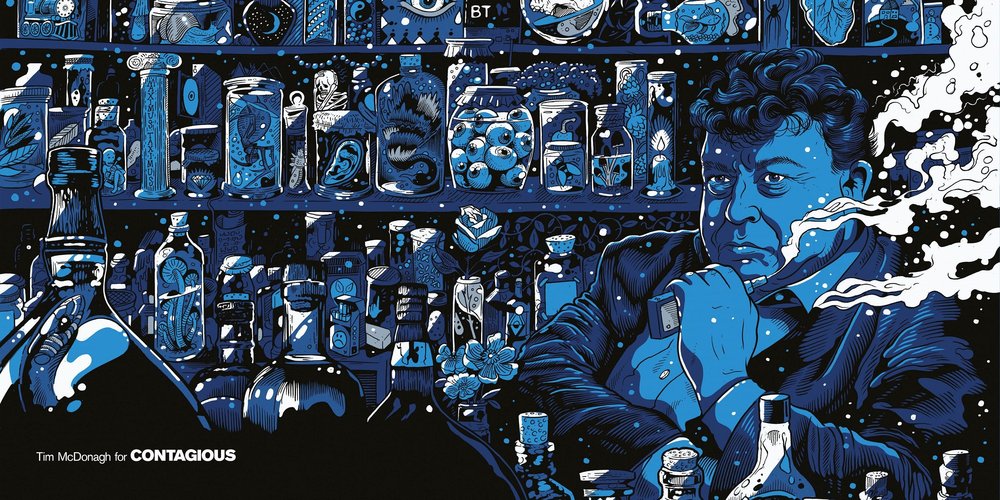Post-rationalisation: The great white lie of advertising strategy /
Why agencies feel the need to post-rationalise their ideas.

It’s called the Baader-Meinhof phenomenon and you have almost certainly experienced it, even if you have never heard of it.
Also referred to as the frequency illusion, the Baader-Meinhof phenomenon* occurs when you learn a new piece of information or notice something for the first time and suddenly feel that you encounter that same thing or piece of information everywhere you turn.
A common example is when someone buys a new car, gets on the road and then notices how many motorists are driving the same model.
I mention the Baader-Meinhof phenomenon not just because it is good trivia but because it was how I came to think about the chasm that exists between how agencies come up with ideas and how they tell people they do.

Artifice foul
The subject first came up because of an agency strategist, who told Contagious about a campaign of which they were particularly proud (rightly so – it was fine work). They had landed upon the strategy by reading an emotional social media message written by a friend, which described a feeling that answered the brief perfectly. Of course, by the time the idea was presented to the client the moment of inspiration had acquired a lot more logic and, by the time the campaign was launched publicly, the idea had become the product of qualitative consumer research.
Shortly after that, I read Rory Sutherland’s new book, Alchemy: The Surprising Power Of Ideas That Don’t Make Sense. In the book, Sutherland notes that this same dynamic occurs in laboratories, workshops and anywhere else new things are made.
‘If you look at the history of great inventions and discoveries, sequential deductive reasoning has contributed to relatively few of them,’ writes Sutherland, adding: ‘It is far more common for a mixture of luck, experimentation and instinctive guesswork to provide the decisive breakthrough; reason only comes into play afterwards.’

The problem, says Sutherland, is that the patrons of those who deal in ideas – clients, to you and me – ‘tend to evaluate decisions by the rigour of the process that produces them’, and this leads to all kinds of artifice.
Another senior strategist would fill me in on just how much of agency life is dedicated to this merry little dance. This senior planner worked at a prestigious shop and said their entire job was to make rough creative ideas more palatable to clients by adding a veneer of logic. The notion that strategy was something you add to a brief before coming up with the creative execution bore about as much relation to their day-to-day job as storks to a midwife.
I was not, before this, completely naive to the realities of the creative process. But to have such a frank discussion and then stumble across multiple sources saying the same thing in quick succession gave me pause. Why is the industry like this?
Sutherland tells Contagious that it’s down to the practice of hourly billing. Agencies ‘have to maintain this ludicrous pretence that they have this process,’ he says, ‘because it makes it possible to charge for something on the basis that you can pretend it’s replicable.’
The first strategist source meanwhile told me that it’s because ‘advertising now needs to work harder’. Not only must ads be well-crafted and speak to the audience, they must contain active ingredients that achieve the client’s objectives, and these must be defended with stats and research. Intuition, even when it is the result of years of experience, just isn’t reassuring when you are a marketer with KPIs to hit.
Andy Nairn, Lucky Generals
Rational ruse
What is the harm of it all, you may ask? As far as the general public is concerned, probably none. It takes talent and hard work to get people to even notice an ad, expecting them to care how it was made is deluded.
And the strategists I spoke with were adamant they would abandon ideas they could not post-rationalise, so there is no suggestion that it compromises the creative process. ‘If we got to the point where the study suggested our idea was wrong, we would definitely go back to the drawing board,’ the first strategist said.
Andy Nairn, a co-founder of creative agency Lucky Generals who has won more IPA Effectiveness Awards than anyone else, goes as far as to say that he is baffled by the way that this industry demonises post-rationalisation.
‘I am a firm believer in strategic rigour and working my way through a commercial problem from start to finish, in the normal way,’ he says. ‘But if I stumble on a better solution along the way, or a great idea pops up unprompted, I’m not going to rule it out just because it hasn’t been preceded by the usual methodology. Otherwise, I’m ruling out something that might be more unexpected, which would be nuts. Instead, I’ll explore it and then apply the usual rigour in reverse, to understand whether my initial excitement is justified. To be honest, any good agency will do this – but usually they’ll retell the story to conceal the shameful truth.’
End the pretend
The thing about the Baader-Meinhof phenomenon is that it is just a by-product of humans’ selective attention. The information or thing you feel stalked by was there before it was brought to your attention, your brain just ignored it for you because it did not deem it valuable enough to raise above the millions of other bits of information it processes every second. In the same way, agencies have probably always smoothed the edges off the creative process for the benefit of clients (although we stand by the argument that there’s now more pressure to do so).
It might point to the conclusion that hourly billing is a fundamentally unsound way to buy creativity, but it doesn’t lead to worse ads. You could even argue that clients demanding logical rationales (whether they arrive before or after the idea) keeps agencies honest.
But there is one good reason to want the shame gone. Contagious believes that, when it comes to creativity, you must learn from the best to be the best. And that means being honest about the process as much as anything else. If this industry could dispense with the need to pretend about how it gets its best ideas, it might even lead to it producing a few more of them.
* The Baader-Meinhof phenomenon takes its name from a left-wing terrorist collective operating in late 20th-century Germany. According to reports, in 1994 a commentator on the St Paul Pioneer Press online message board used the name to describe the frequency illusion, after learning about the obscure gang for the first time and then seeing it referenced somewhere else less than 48 hours later.
Contagious is a resource that helps brands and agencies achieve the best in commercial creativity. Find out more about Contagious membership here.
Want more of the same? /
We don’t just write about best-in-class campaigns, interviews and trends. Our Members also receive access to briefings, online training, webinars, live events and much more.







